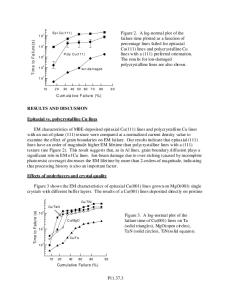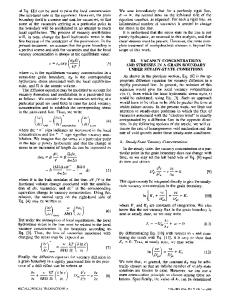The Effect of Cluster Interactions on Electromigration Induced Stress Evolution in Confined Metal Lines
- PDF / 429,921 Bytes
- 6 Pages / 414.72 x 648 pts Page_size
- 47 Downloads / 326 Views
ABSTRACT In near-bamboo interconnect lines used in advanced integrated circuits, electromigration flux divergences occur at the intersection between polycrystalline cluster segments (where grain boundaries offer a fast diffusion path), and bamboo segments (where there are no grain boundaries along the line length). For confined, passivated metal interconnects, these flux divergences are linked to the evolution of significant mechanical stresses in the metal. A quasisteady state stress distribution builds up relatively quickly in the cluster segments and remains unchanged until there is significant diffusion into the bamboo segments. The stress profile of a given cluster then becomes dependent on neighboring clusters as well as the diffusivity and flux in the separating bamboo segments. Previous analyses of electromigration failure in interconnect lines have focused on the distribution of cluster lengths and the stress build up in isolated cluster segments. In this paper, we show that the bamboo length distribution can strongly affect the interaction between clusters and the evolution of stresses in a near-bamboo interconnect during electromigration. We present simulation results, using a ratio of cluster to bamboo diffusivity Dc/Db=100, which show greater interactions and larger maximum stresses in cluster segments as the average bamboo segment length decreases and as the bamboo segment length distribution widens. INTRODUCTION
Electromigration is an important reliability concern for chip-level metal interconnects. Under an applied current and in the absence of strong temperature gradients, the induced atomic flux, Ja, is given by the following equation[l]: Ja(x) =
Da/kT (da/dx + G)
(1)
where x is the distance along the line length, Da is the atomic diffusion coefficient at the location x, kT is the thermal energy, and (y is the mechanical stress in the metal interconnect. Note that a stress gradient acts as a driving force for atomic flux. G=Eq*/Q is the electromigration driving force, where E is the applied electric field, q* is the absolute value of the effective charge, and Q is the atomic volume. The effective charge q* is in the range of 4e to 8e for Al [2], where e is the electronic charge. A divergence can occur in this electromigration-induced atomic flux if, for example, the effective atomic diffusivity changes along the metal interconnect line due to microstructure or variation in the geometry. These atomic flux divergences can give rise to void formation and open circuits (where atoms are being depleted), or hillock formation and short-circuits between nearby interconnects (where atoms are being accumulated). [3] In an encapsulated interconnect structure, this divergence in material transport also gives rise to local volume strains in the metal, which can 197 Mat. Res. Soc. Symp. Proc. Vol. 391 01995 Materials Research Society
result in high local stresses. The stress evolution in an interconnect can have a very strong effect on the processes which result in electromigration damage.[2, 4] For examp
Data Loading...











